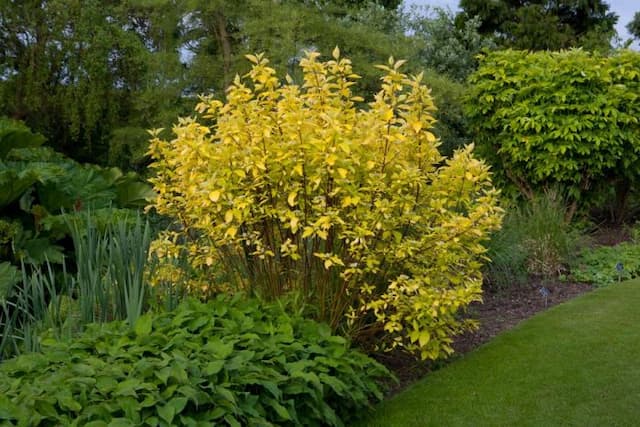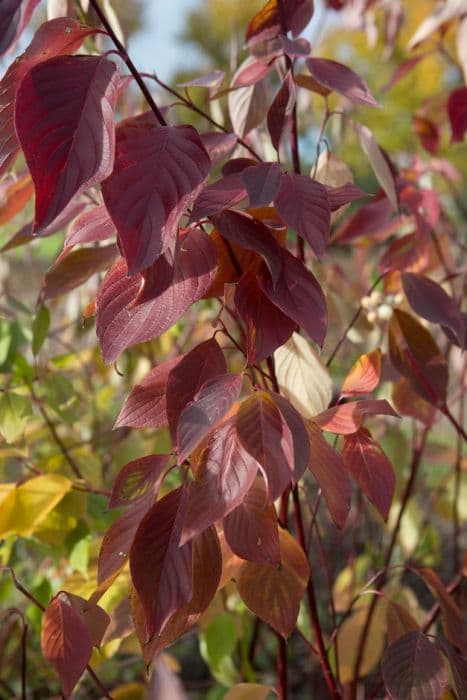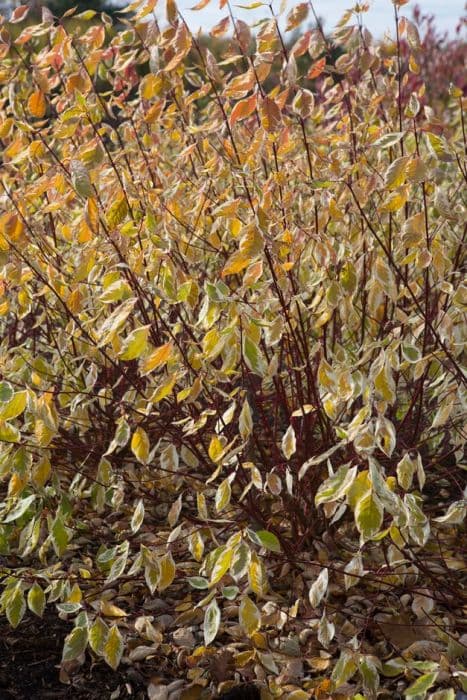Tatarian Dogwood Cornus alba Ivory Halo = 'Bailhalo' (PBR)
![dogwood [Ivory Halo]](/_next/image?url=https%3A%2F%2Fplants-admin.emdemapps.com%2Fimages%2Fplants%2F%2Fimages%2F604b535cbcb9a.png&w=3840&q=75)
ABOUT
Cornus alba 'Ivory Halo', also known as Tatarian Dogwood 'Ivory Halo', is a deciduous shrub with a striking appearance that makes it a popular choice in many gardens. It is best known for its variegated foliage and vibrant winter stems. Throughout the growing season, its leaves present a blend of green centers framed by creamy white margins. The leaves are oval to lance-shaped and provide a cheerful and colorful display. In spring, the plant produces small, inconspicuous white flowers that offer a subtle contrast to the variegated leaves. These flowers eventually give way to white berries that can attract birds to the garden. As the leaves fall away in autumn, the Tatarian Dogwood 'Ivory Halo' reveals one of its most dramatic features: the red to coral-colored stems that stand out during the winter months, creating a warm and appealing landscape against the often bleak backdrop of the cold season. This colorful stem presentation ensures that the shrub continues to provide interest throughout the year.
About this plant
 Names
NamesSynonyms
Ivory Halo Dogwood, White Gold Dogwood, Tatarian Dogwood Ivory Halo, Variegated Red Twig Dogwood.
Common names
Cornus alba 'Bailhalo'.
 Toxicity
ToxicityTo humans
The Cornus alba 'Ivory Halo', commonly known as Tatarian Dogwood, is not generally considered toxic to humans. However, as with many ornamental plants, it is not intended for human consumption. Ingesting parts of the plant, especially in large quantities, could potentially cause gastrointestinal discomfort, including nausea, vomiting, or diarrhea. It is always advisable to keep ornamental plants out of the reach of small children who might inadvertently ingest plant parts.
To pets
The Tatarian Dogwood is also generally considered non-toxic to pets; this includes dogs and cats. While it is not known for being poisonous, eating large amounts of the plant material could lead to gastrointestinal upset for your pet. Symptoms could include vomiting, diarrhea, and abdominal pain. As a precaution, it is still a good idea to prevent your pets from chewing on or ingesting parts of this plant. If your pet exhibits unusual symptoms after ingesting this plant, consult a veterinarian.
 Characteristics
CharacteristicsLife cycle
Perennials
Foliage type
Deciduous
Color of leaves
Variegated
Flower color
White
Height
5-6 feet (1.5-1.8 meters)
Spread
5-6 feet (1.5-1.8 meters)
Plant type
Shrub
Hardiness zones
3-7
Native area
Siberia, Manchuria, Korea
Benefits
 General Benefits
General Benefits- Aesthetic Appeal: The plant features variegated leaves that create visual interest in the landscape throughout the seasons.
- Seasonal Interest: It has bright red stems which provide dramatic winter color when the landscape is largely dormant.
- Ease of Care: The plant is known for being low-maintenance, requiring minimal care once established.
- Wildlife Habitats: It provides shelter and nesting sites for birds during the growing season.
- Soil Erosion Control: Its root system helps in stabilizing soil, which can prevent erosion.
- Tolerance: It exhibits a good tolerance to a variety of soil conditions and can withstand urban pollution.
- Adaptability: The Tatarian Dogwood can adapt to a range of light conditions, from full sun to partial shade.
- Flexible Landscaping: It can be used in a variety of landscaping applications, from hedges to stand-alone specimen plants.
- Hardiness: It is generally hardy in many climates, tolerating cold winters well.
 Medical Properties
Medical PropertiesThis plant is not used for medical purposes.
 Air-purifying Qualities
Air-purifying QualitiesThis plant is not specifically known for air purifying qualities.
 Other Uses
Other Uses- Crafting Material: The bright red stems of the Red Twig Dogwood can be harvested in winter and used in basket weaving or for making crafts and wreaths.
- Wildlife Shelter: The dense foliage can provide shelter and nesting sites for birds and small animals in the garden.
- Natural Dyes: The bark and leaves can be used to produce natural dyes for textiles or crafts.
- Photography Backdrop: This shrub, with its vibrant winter stems, can serve as a beautiful backdrop for winter photography.
- Erosion Control: Planted on slopes or river banks, Red Twig Dogwood can help prevent soil erosion due to its root system.
- Garden Structure: During winter, the distinctive stems provide structural interest in an otherwise dormant garden.
- Pond Edging: Red Twig Dogwood can be used around ponds or water features for added color and foliage near water.
- Privacy Screening: When planted in a row, these shrubs can create a dense screen that can increase privacy in a garden or yard.
- Decorative Mulch: The leaves and bark can be chipped to create an organic, decorative mulch for garden beds.
- Seasonal Arrangements: Branches can be cut and used in seasonal floral arrangements, especially in fall and winter.
Interesting Facts
 Feng Shui
Feng ShuiThe Red Twig Dogwood is not used in Feng Shui practice.
 Zodiac Sign Compitability
Zodiac Sign CompitabilityThe Red Twig Dogwood is not used in astrology practice.
 Plant Symbolism
Plant Symbolism- Vitality: Cornus alba, commonly known as Tatarian Dogwood, often symbolizes vitality due to its hardy nature and the ability to withstand cold climates.
- Protection: The sturdy stems of the Tatarian Dogwood, which can be used to create barriers or hedges, may represent safety and protection.
- Purity: The ivory-colored halo variegation of the leaves of this particular cultivar, 'Ivory Halo', can be associated with purity and innocence.
- Hope: The bright red stems of the Tatarian Dogwood that stand out in the winter landscape are often seen as a symbol of hope and the promise of spring to come.
- Stability: Its ability to grow in various conditions and soil types makes Tatarian Dogwood a symbol of stability and adaptability.
- Renewal: The seasonal cycle of the plant, with new growth appearing each spring, is emblematic of regeneration and new beginnings.
 Water
WaterTatarian Dogwood 'Ivory Halo' should be watered thoroughly until the ground is moist to a depth of a few inches, approximately once a week during its growing season. More frequent watering may be necessary during periods of extreme heat or if it's planted in well-draining soil. During the winter months, reduce watering to every couple of weeks, allowing the soil to dry out slightly between watering sessions. It's important to avoid overwatering, as this can lead to root rot. Generally, you should expect to use about 1 to 2 gallons per watering session, ensuring even distribution around the root zone.
 Light
LightThe Tatarian Dogwood 'Ivory Halo' thrives best in full sun to partial shade conditions. It prefers a spot that receives direct sunlight for at least 4 to 6 hours a day, but it can tolerate some light shade, especially in the hotter parts of the day. Avoid deeply shaded areas, as insufficient light can lead to reduced foliage vibrancy and poor flowering.
 Temperature
TemperatureThe Tatarian Dogwood 'Ivory Halo' is hardy and can tolerate winter temperatures as low as -30 to -20 degrees Fahrenheit. During the growing season, it prefers a temperature range of 60 to 75 degrees Fahrenheit for optimal growth. However, it can survive summer highs up to 95 degrees Fahrenheit with proper care and watering.
 Pruning
PruningPruning the Tatarian Dogwood 'Ivory Halo' encourages healthy growth and maintains its attractive shape. Prune in late winter or early spring before new growth begins. Remove any dead or damaged branches, thin out areas that are congested to improve air circulation, and shape the shrub as desired. It's typically recommended to prune every year to promote strong stems that will have the brightest red color during the winter.
 Cleaning
CleaningAs needed
 Soil
SoilThe Ivory Halo Dogwood prefers a fertile, well-drained soil mix with consistent moisture. It thrives in slightly acidic to neutral soil, with an optimal pH range of 5.5 to 7.0. A mix of loamy soil, peat, and some sand is favorable for drainage and nutrient retention.
 Repotting
RepottingIvory Halo Dogwoods, being shrubs, are not commonly repotted as they are typically planted directly in the ground. If grown in containers, they should be repotted when rootbound or every 2 to 3 years to refresh the soil.
 Humidity & Misting
Humidity & MistingIvory Halo Dogwood is adaptable to a range of humidity levels and does not have specific humidity requirements. It should do well in average outdoor humidity conditions where it is generally grown.
 Suitable locations
Suitable locationsIndoor
It's challenging to grow indoors; prioritize ample light and space.
Outdoor
Plant in well-drained soil; full sun to partial shade.
Hardiness zone
3-7 USDA
 Life cycle
Life cycleCornus alba 'Ivory Halo', commonly known as Tatarian Dogwood, begins its life cycle with seed germination, occurring in late spring as soil temperatures rise. Seedlings emerge and develop into young plants with characteristic green and white variegated leaves, undergoing vegetative growth during the spring and summer months. As the plant matures, it undergoes flowering in late spring to early summer, producing small, inconspicuous white flowers that attract pollinators. Following pollination, small blue-white drupes form, providing food for birds and allowing for seed dispersal. The shrub experiences a period of dormancy in the winter, during which the bright red stems become a prominent ornamental feature in the landscape. Yearly in spring, the plant can be pruned to promote vigorous growth and maintain its compact shape, completing its annual growth cycle and preparing for the next season.
 Propogation
PropogationPropogation time
Late Summer to Early Autumn
The most popular method of propagation for Cornus alba 'Ivory Halo', commonly known as Tatarian Dogwood, is through softwood cuttings. This process typically occurs in late spring to early summer, when new growth is abundant and stems are flexible but mature enough to take root. Cuttings should be about 4 to 6 inches (10 to 15 centimeters) long, with a few leaves left on the top. It's crucial to make a clean cut just below a leaf node where the concentration of growth hormones is high. The cutting should then be dipped into rooting hormone and planted in a well-draining potting mix, ensuring the leaf nodes are buried. To maintain high humidity, a plastic bag or cover can be placed over the pot, and it should be kept in indirect sunlight until roots are established, which typically takes a few weeks.

![Dogwood [Baton Rouge]](/_next/image?url=https%3A%2F%2Fplants-admin.emdemapps.com%2Fimages%2Fplants%2F%2Fimages%2F604b59cf0fefd.png&w=640&q=75)







![Dogwood [Venus]](/_next/image?url=https%3A%2F%2Fplants-admin.emdemapps.com%2Fimages%2Fplants%2F%2Fimages%2F604b58a531da1.png&w=640&q=75)